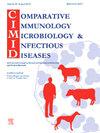印度古吉拉特邦有症状和无症状犬肠道病毒的分子检测
IF 2
3区 农林科学
Q4 IMMUNOLOGY
Comparative Immunology Microbiology and Infectious Diseases
Pub Date : 2025-05-09
DOI:10.1016/j.cimid.2025.102356
引用次数: 0
摘要
最近,犬星状病毒(CaAstV)和SARS-CoV-2与犬冠状病毒(CCoV)、犬细小病毒(CPV)和犬瘟热病毒(CDV)等已知病原体一起,成为导致犬病毒性胃肠炎的新发现病原体。为了研究这些病毒在印度的分子流行病学,收集了腹泻和健康犬的粪便样本(n = 168),并记录了动物的历史。采用病毒特异性引物进行实时PCR鉴定。分别对CaAstV和CPV阳性扩增子进行测序,以确定诊断,并了解研究地区流行的病毒株/变体。其中,CPV-2(73.80 %)是最常见的病毒,其次是CDV(11.90 %)、CaAstV(5.95 %)、SARS-CoV-2(3.57 %)和CCoV(1.19 %)。在临床健康犬中,CPV-2、CDV、CaAstV、SARS-CoV2和CCoV分别占57.73 %、7.21 %、3.09 %、1.03 %和0 %。腹泻犬CPV-2、CDV、CaAstV、SARS-CoV2和CCoV的患病率分别为95.77 %、18.30 %、9.86 %、7.04 %和2.81 %。27.56 %(35/127)的阳性标本存在合并感染,以CPV-2和CDV合并感染最为常见。CDV和CPV感染也见于未完全或完全接种疫苗的狗。本文章由计算机程序翻译,如有差异,请以英文原文为准。
Molecular detection of enteric viruses in symptomatic and asymptomatic dogs in Gujarat, India
In the recent past, canine astrovirus (CaAstV) and SARS-CoV-2 have emerged as newly identified agents contributing to canine viral gastroenteritis alongside established pathogens viz. canine coronavirus (CCoV), canine parvovirus (CPV), and canine distemper virus (CDV). To study the molecular epidemiology of these viruses in India, faecal samples (n = 168) were collected from diarrhoeic and healthy dogs and history of animals was recorded. Viruses were identified with real-time PCR using virus-specific primers. Sequencing of CaAstV and CPV positive amplicons was done for confirmation of diagnosis and to know the prevalent strains/variants of viruses in the study area, respectively. 75.60 % (127/168) of the samples were positive for intended viruses, and CPV-2 (73.80 %) was found as the most prevalent virus, followed by CDV (11.90 %), CaAstV (5.95 %), SARS-CoV-2(3.57 %) and CCoV (1.19 %). In clinically healthy dogs, CPV-2, CDV, CaAstV, SARS-CoV2 and CCoV were recorded in 57.73 %, 7.21 %, 3.09 %, 1.03 % and 0 % of samples, respectively. In diarrhoeic dogs, the prevalence of CPV-2, CDV, CaAstV, SARS-CoV2, and CCoV was found to be 95.77 %, 18.30 %, 9.86 %, 7.04 % and 2.81 %, respectively. Co-infections were present in 27.56 % (35/127) of the positive samples, CPV-2 and CDV formed the most prevalent combination. CDV and CPV infection was also seen in incompletely or fully vaccinated dogs.
求助全文
通过发布文献求助,成功后即可免费获取论文全文。
去求助
来源期刊
CiteScore
4.60
自引率
0.00%
发文量
102
审稿时长
40 days
期刊介绍:
Comparative Immunology, Microbiology & Infectious Diseases aims to respond to the concept of "One Medicine" and to provide a venue for scientific exchange. Based on the concept of "Comparative Medicine" interdisciplinary cooperation between specialists in human and animal medicine is of mutual interest and benefit. Therefore, there is need to combine the respective interest of physicians, veterinarians and other health professionals for comparative studies relevant to either human or animal medicine .
The journal is open to subjects of common interest related to the immunology, immunopathology, microbiology, parasitology and epidemiology of human and animal infectious diseases, especially zoonotic infections, and animal models of human infectious diseases. The role of environmental factors in disease emergence is emphasized. CIMID is mainly focusing on applied veterinary and human medicine rather than on fundamental experimental research.

 求助内容:
求助内容: 应助结果提醒方式:
应助结果提醒方式:


